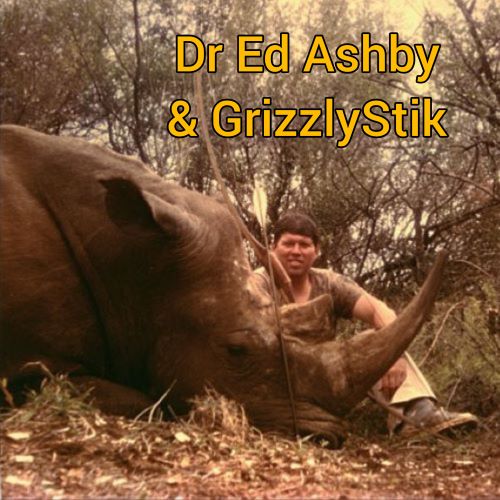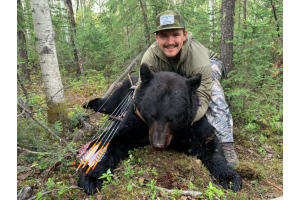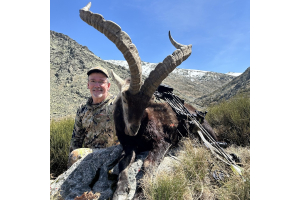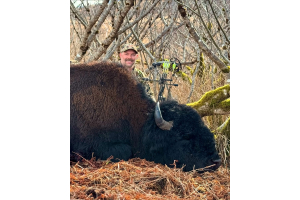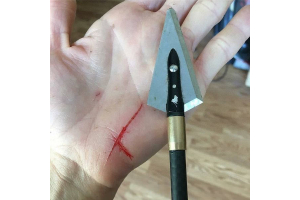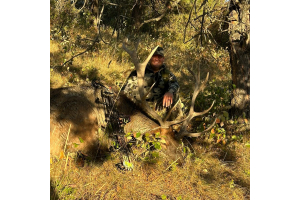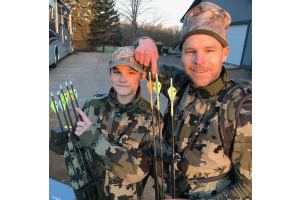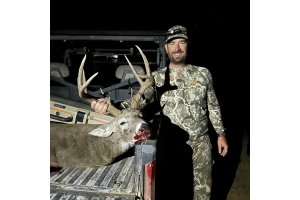2019 Terminal Arrow Performance Update - The Penetration Enhancing Factors By Dr. Ed Ashby
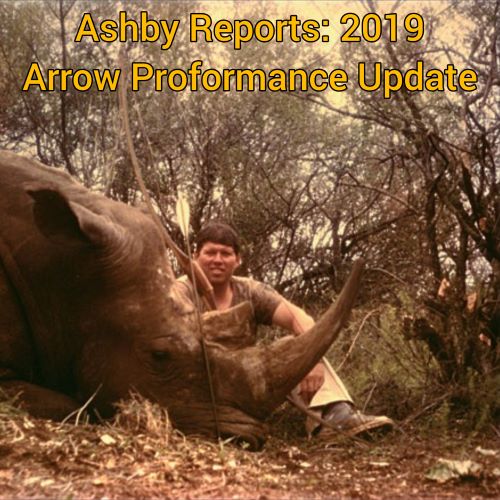
Copyright 2019 Dr. Ed Ashby 2019 Terminal Arrow Performance Update The Penetration Enhancing Factors By Dr. Ed Ashby
Penetration is Paramount
In 2007, the 12 penetration-enhancing factors were discussed to explain how each has an effect on penetration, and where each ranks, based on nearly thirty years of data collection. Study and analysis of the penetration enhancing factors have continued over the last decade. Using penetration-enhanced arrow systems based upon the Study’s recommendations, data has been collected not only from controlled test shots but, more importantly, from real hunting shots, by numerous hunters, on over 1700 buffalo (both Cape and Asian), 96 elephants, several hippos, and countless bison, elk, moose, bear, eland, kudu, sable, wildebeests, zebra, and lesser game. The following is based on the additional data collected over the last decade using compound bows, longbows, recurves, and crossbows. The Study’s previous findings have been strongly validated.
The goal of every bowhunter should be to achieve the most penetration possible on an animal, with the intent of a full pass-through. This should come as no surprise. Findings of the Royal College of Veterinary Science concluded that a pass-through shot is more lethal than having the arrow remain in the animal. The balance of the medical community agrees; while still in place, pressure of an embedded object upon the tissues retards blood loss. Only trained medical professionals should remove an embedded object, and then only once measures to deal with the increase in blood loss are available. An arrow shaft remaining in the wound channel applies pressure on the tissues, retarding blood loss. From a bowhunter’s perspective, this is less effective than an arrow that passes all the way through. At the very least, an arrow shaft remaining in the wound channel increases the time before the animal expires. This means longer tracking distances with less blood trail.
For complete pass-through shots, anecdotal evidence from the hunted-animal kills also indicates a significant reduction in an animal’s level of alarm at the hit, often showing little or no awareness that they had been shot. This resulted in a very high number of these animals falling within sight of the hunter, resulting in exceedingly easy animal recovery. No tracking or blood-trailing required.
A Word About Penetration Testing
In today’s internet world, one can find a myriad of information on arrow penetration…and much misinformation. Real tissues are neither foam, wood, cardboard, metal, phonebook nor sand, and these tell one little about what results would be seen in real tissues. Some people still test with ballistic gel. This test medium was tried many times during the Study’s testing but it also failed to give results that corresponded to the real-tissue outcomes. Ballistic gel is designed to simulate soft tissue cavitation by bullets. Bullets are little influenced by either the level of tissue-fiber tonus or the degree of blood suffusion from the tissues during projectile penetration; both significant factors affecting arrow penetration in soft tissues.
Even when testing employs meat and bone it is important to realize that testing on other than exceedingly fresh tissues will not yield results comparable to living tissues. In the Study’s testing, all shots on downed animals are taken within 30 minutes of animal expiration. This is because tissue changes occur rapidly after death, providing penetration results that do not correlate with data from hunted animals. This is why the Study employs dual databases; one containing test shots on freshly-downed animals and one containing actual hunting kills. This provides a method for verifying that outcomes from downed-animal shots correlate accurately with shots taken during actual hunting situations.
Why does fresh and living tissues yield different outcomes than non-fresh tissues? For many of the same reasons ballistic gel gives different results from fresh and/or living tissue. In fresh and living soft tissues, the muscle fibers retract as they are cut by the broadhead. The retracting fibers cause the laceration to spread apart, opening the wound channel. This does not occur after either tissue flaccidity or rigor mortis sets in. The blood-suffused environment present in fresh and living tissues provides a lubricating factor to a penetrating arrow: a factor not present in other test mediums. After death, even bones rapidly undergo changes which affect how they flex and fracture as impact force is applied. Evaluate carefully how, and under what conditions, any arrow penetration testing you see was conducted.
Ranking the Factors
The following rankings are dynamic. Importance of each factor shifts under certain conditions. For example, arrow mass above the Heavy Bone Threshold isn't very important on a shot impacting only soft tissues, but it becomes very important when a heavy bone is hit. Enhancing any factor boosts your arrow's penetration-potential; diminishing it reduces your arrow’s penetration potential.
It is impossible to anticipate what each hit will be, and impossible to know beforehand which penetration factors will become most important. This is why it is important to maximize your arrow’s penetration potential. Maximizing successful hits requiresthe incorporation of as many penetration-enhancing factors as possible. To optimize effectiveness the design of your broadhead and arrow must augment each other and work together as a complementary arrow-system. To maximize successful hits always try for the best, but be prepared for the worst.
- Structural Integrity
- Structural integrity of the entire arrow system is the most important factor. It applies to every aspect of the arrow, from the broadhead's tip and edge strength to the nock. Even a tiny tip-bend, such as a slight tip curl, results in an average penetration loss of 14%. Structural integrity is a requirement for every hunting arrow; a 'must have' arrow design feature without which no other factor can be relied upon.
- Arrow Flight
Arrow flight is number two in importance. It's the ’enabler’ for other factors, delivering more usable force on target and permitting each additional factor to work at full efficiency. Poor flight squanders arrow force.
If your broadheads have a different point of impact than your field points then your setup is not truly tuned. You should spare neither effort nor expense in achieving absolute perfect arrow flight. Even with every other factor in place, without good arrow flight you will still have poor arrow performance. However, ignore the other design features and all you end up with is a perfectly flying arrow that still performs poorly on some hits, negating the perfect-flight advantage.
- The Arrow’s Weight Forward of Center (FOC)
The Arrow’s Weight Forward of Center (FOC) … or how close the arrow’s balance point is to the arrow’s tip … comes in as the number three Factor. Using arrows having Extreme or Ultra-Extreme FOC (EFOC and Ultra-EFOC) does more than any other feature except flight-quality to maximize the effect other factors offer. Ultra-EFOC is Study-defines as above 30%, using the AMO Standard formula. (The AMO Standard Formula is shown in the Prologue to the 2007 Updates.) EFOC is defined as 19% to 30% FOC. The first measurable tissue-penetration gains due to FOC are manifest at the EFOC level (19%), with penetration gain continuing to increase as FOC increases.
In fresh and living tissues, all EFOC and Ultra-EFOC tests show very, very high penetration gain over arrows having normal FOC (12% and less) and high FOC (from 12% up through 18%). For EFOC arrows that have incorporated most of the other penetration-enhancing features, this has been quantified. Penetration gains range from approximately 40% to upwards of 60%, depending on which arrow-sets are compared (See 2005 Update, part 2 and 2007 Update, Part 4). Ultra-EFOC testing shows even greater penetration gains than EFOC, but ‘equal arrow' data is still insufficient to accurately quantify the exact degree of gain. (See 2008 Updates, Parts I through 6). It is worthy of note that, in the actual hunt data from the past decade, penetration-enhanced arrow systems having high amounts of FOC (24% to 30-plus %) have yielded a very high percentage of complete passthrough hits on Cape and Asian buffalo … and even a few instances of complete passthroughs on elephant and hippo!
The preponderance of actual complete-passthrough hunting shots on buffalo have occurred with compound bows having draw-weights from 65 to 70 pounds. Exactly why, when using directly comparable arrow-system setups, compound bows in the 65 to 70-pound draw-weight range are yielding a much higher rate (percentage) of passthrough shots on hunted buffalo than are the compound bows having higher draw weights remains, at this time, an unknown, though I do have a suspicion why. Nonetheless, this outcome data from hunted buffalo is clearly present, and at a significant level. This is an item that warrants further testing.
- Mechanical Advantage
Mechanical Advantage (MA) of the broadhead ranks as number four. Mechanical advantage refers to how steep the angle is on the blades of the broadhead. Just like an inclined ramp, the longer the length of the ramp in relation to its rise, the less energy it takes to get to the top of the incline. Were this not true it’s a sure bet that wheelchair ramps for the handicapped would be short and steep!
The mechanical advantage of a broadhead also changes if it has more blades. If two broadheads have the same length and width, but one has more blades, the one with more blades will have a poorer mechanical advantage and will require more energy to penetrate. The degree of penetration gain varies, depending on which broadheads are compared. Broadhead MA has a more pronounced influence on the outcome penetration of a perfectly flying, structurally secure arrow than any other factor except FOC.
Higher MA increases the ‘work’ your arrow can do with whatever 'useful force' is available. Its advantage is applicable to all arrows, of all designs. However, the more efficient the rest of your arrow is the more penetration-gain higher broadhead MA yields (See 2007 Update, part 3 and 2008 Update, part 3, How Arrow Efficiency Compounds the Penetration Gain).
- Shaft Diameter
Shaft diameter to ferrule diameter ratio is number five. It shows an average 10% penetration gain when the shaft is at least 5% smaller than the broadhead's ferrule diameter; compared to a case where shaft and broadhead ferrule have equal diameter. When shaft diameter exceeds that of the broadhead’s ferrule penetration is decreased by an average of 30%; compared to a case where shaft and broadhead ferrule have equal diameter. That's a 40% difference in tissue penetration when a shaft having a favorable ratio is compared to one with an unfavorable ratio. (See 2004 Update, Part 2.) Regardless of other design factors present or absent, you should avoid use of arrows having a shaft diameter greater than that of your broadhead's ferrule. Ideally, your arrow's shaft should be at least 5% smaller in diameter than your broadhead's ferrule.
Although we have had advancements in modern arrow production, and many companies produce smaller shafts, this is still a popular issue due to the fact that some broadheads have narrow ferrules and are not built to be used on a .245” diameter shaft. One should pay close attention to this when selecting their arrow shaft and broadhead and ensure that, preferably, the broadhead’s ferrule is larger than the shaft’s diameter but, for certain, no smaller than equal to the shaft’s diameter.
- Arrow Mass
Arrow mass is closely related to arrow weight, but isn't exactly the same. When it comes to calculating either arrow force or arrow energy, mass is the correct term. However, unless doing these calculations, you can think of ‘arrow mass’ as being ‘arrow weight.’
Greater arrow mass increases bow efficiency. It absorbs more of the bow's stored energy when fired. That means more arrow force. But there’s more. When all else is equal, an arrow's tissue penetration is directly proportional to its momentum. That’s because momentum is, by definition, a measure of a forward-moving arrow’s impetus; the arrow’s forward force, which must be met by an equal amount of resistance before the arrow stops its forward movement. Don’t confuse this to mean two different arrows penetrate equally because they have equal momentum. Arrow design influences how efficiently an arrow’s force is used. Even when arrows have identical profiles, how much of the momentum comes from arrow mass and how much from arrow velocity is also a factor. All momentum is not equal.
Momentum belongs to the arrow; it is a property of the arrow, carried within it. It is derived from the arrow's forward motion and the arrow’s mass. As an arrow penetrates velocity is shed, but the arrow’s mass remains constant. At equal impact force (equal arrow momentum), the heavier your arrow the longer it retains momentum and the longer it takes to stop. The result is deeper tissue penetration.
Further benefits of heavier arrow mass include less wind drift, smoother release, a significantly quieter bow and less vibration/hand shock.
You should always use the heaviest arrow possible that has a trajectory that you still find acceptable. Even with every other penetration-enhancing factor in place, greater arrow mass still equates to more usable force, and more outcome-penetration (See article: Momentum, Kinetic Energy, and Arrow Penetration.)
Please note that the foregoing makes little mention of the arrow’s Kinetic Energy (KE). That is because KE is not a predictor of outcome tissue penetration and, by its very definition, not a measure of an arrow’s force. The last decade of data, collected from thousands of shots from real hunting situations, provides clear evidence that arrow Kinetic Energy is more sales hype than useful indicator of terminal arrow performance. Kinetic Energy should be used as neither guideline nor requirement for terminal arrow performance.
- Blade Edge Finish
A smooth, beard-shaving sharp, honed and stropped edge works best. Its advantage is most pronounced in fibrous tissues. In fibrous tissues it shows a 26% advantage over a smoothly filed-sharpened edge, and a 60%-plus advantage over 'Hill type' serrated edges. It's an advantage available for all broadhead designs, for all arrows. (See 2004 Update, Part 1). The thinnest, smoothest, sharpest edge one can achieve - while still maintaining an edge undamaged during penetration - slices tissues with the greatest efficiency, creating the maximum amount of blood loss.
- Shaft Profile
Tapered shafts show an 8% penetration advantage over parallel shafts, and 15% over barrel-taper shafts. Parallel shafts show a 7% advantage over barrel-tapered shafts. This is applicable to all arrows and shaft materials, on all hits. (See Arrow Lethality, Part 2: The Natal Study and 2004 Update, Part 2.)
- Broadhead/Arrow Silhouette
Any rough or irregular surface increases arrow drag in all tissues. Its effect is more pronounced during bone penetration. The ‘less bumpy’ your arrow and broadhead’s silhouette the more effortlessly it passes through tissues. How gradually and smoothly the broadhead’s ferrule fades into the blade becomes a major penetration factor when heavy bone is hit. (See 2007 Update, Parts 4 and 7.)
Additional ‘slickness’ helps too. Shaft finish has a demonstrated penetration-effect, but the degree has not been quantified. Though one finish can be compared to another the Study has no method to define the frictional coefficient of each in a blood-suffused tissue environment. Your arrow shaft’s finish should be as smooth and ‘slick' as possible.
A Teflon broadhead finish offers advantages. When comparing the same broadhead with and without Teflon finish, coated heads averaged 12% more penetration on soft tissue hits. There appears to be no effect on bone penetration.
The crucial element is to have as few 'ups, downs, bumps and lumps’ along the arrow's profile as possible. That, of course, excludes the one step-down your arrow should have; immediately rearward of your broadhead's ferrule.
- Type of Edge Bevel
Type of edge bevel comes in at number ten, but on shots impacting bone the type of edge-bevel jumps well forward on the list of important factors; immediately behind mass-weight above the heavy bone threshold. Single-bevel broadheads cause arrow rotation during penetration, applying torque to bones as they pass through. With the massive amount of data now available from both test shots and hunted animals it can be stated with absolute certainty; single-bevel broadheads consistently cause a high frequency of massive bone splits, especially in the long-bones. Throughout the Study, not a single large bone-split has been observed with any double-bevel broadhead.
When broadheads identical in all aspects except type of edge-bevel are tested, side by side, on identical arrows, single-bevel versions demonstrate sizable penetration-increases in 100% of cases involving bone impact. The amount of gain varies by broadhead profile, but ranges from 14% to 58%. Single-bevel broadheads also show a penetration advantage in soft tissue, but to a lesser degree.
Most hits involve bone impact of one type or another. There is no down-side to using single-bevel broadheads on any type hit. There is a demonstrated up-side, especially when bone is hit. (See "Why Single-Bevel Broadheads"; and also 2005 Update, Part 1 and 2007 Update, Part 4.)
When using single-bevel broadheads it is important to match the direction of fletching-induced arrow rotation in flight to the direction of bevel-induced rotation during tissue penetration. With a right single-bevel use right-wing feathers/vanes. With a left single-bevel use left-wing feathers/vanes.
- Tip Design
Tip design's greatest importance is on shots impacting bone. The Tanto tip shows the best performance. Tested side-by-side with identical broadheads on identical arrow setups, it averages a lower damage rate than any other design tested. It shows the best outcome penetration in bone, averaging 110% better than the worst-performer tested (concave) and 27.5% better than the second-best performer (rounded). (See 2005 Update, Part 1).
Of all tip profiles, the Tanto demonstrates the lowest tendency to skid off bones on angular impacts. Data suggests that a needle tip might do as well or better at retarding bone-skids, were it not for their high damage rate. 'Needle tip’ should not be equated to conical or pyramidal, so-called ‘bone breaker’ tips, that come to a sharp point. These often initiate some bone-skids.
- Arrow-Mass Above the Heavy Bone Threshold
Arrow-mass above the Heavy Bone Threshold is placed this low because it has little significance on shots impacting only soft tissues. On a heavy bone impact this factor will jump to very near the head of all factors; excepting only structural Integrity and, perhaps, quality of arrow flight (See 2005 Update, Part 6). The degree of arrow FOC shows no effect on the Heavy Bone Threshold, but does show a significant penetration increase once the bone is breached (See 2008 Update, Parts 1 through 6).
Bone impacts of one type or another occur on most hits, and bad hits can occur at any time. Regardless of other design factors used, there is a marked drop in the frequency of penetrating heavy bone when total arrow mass is below this threshold. The threshold is at, or very near, 650 grains of total arrow mass. Its persistence appears little affected by sizable increases in impact force, as provided by ultra-high FOC values.
- Cutting Diameter of the Broadhead
Broadhead cutting diameter is last on the list of the 12 penetration-enhancing factors. It has been tested extensively over the years, in many different animal species, in many different body sizes, at many different impact angles, using many different broadhead designs.
Surprisingly, the amount of penetration does not decrease as the cutting diameter increases. In tests comparing broadheads with the same profile, and the same amount of blade exposure, but with different cutting diameters, penetration remains the same, with one exception; when bone is hit. When bone is hit, penetration decreases as the cutting diameter increases. This is in large part because broadheads having a larger cutting diameter are more prone to edge deflection, and more prone to rotating on angular impacts.
There is one other consideration. Smaller diameter broadheads give the animal less opportunity to dislodge the broadhead. Even broadheads having complete pass-through on an animal can sometimes become dislodged as the animal runs away, especially if the arrow is left in the animal for some period of time before recovery. The smaller the cutting diameter the less leverage the broadhead has to work against the arrow when the animal attempts to dislodge it.
Summary
Every factor ranking is dynamic. The importance of each varies under different circumstances. However, all of them are important. Penetration enhancing factors either boost your arrow's penetration potential or diminish it. You need to maximize your arrow’s penetration potential. An arrow that enhances more factors is more likely to penetrate an animal's tissue effectively. Always strive for the best, but be prepared for the worst.



